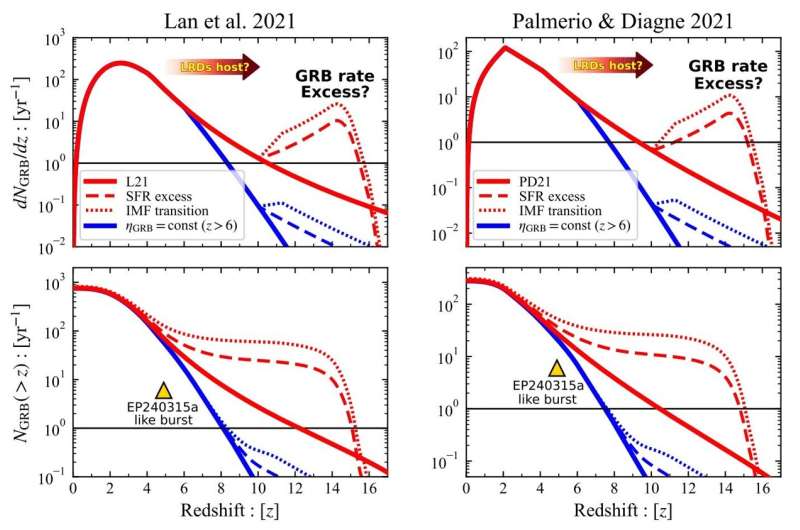Among its other notable achievements and puzzles, the James Webb Space Telescope (JWST) has found a larger number of bright galaxies in the distant universe than was expected. While scientists are still debating the excess, one research group has proposed that gamma-ray bursts can be used as a powerful probe to examine the surplus, which could also observe the formation of stars and galaxies in the distant, early universe.
JWST recently observed the most distant galaxy ever observed, which formed just 300 million years after the Big Bang. It’s now on the far edge of the observable universe, where objects are receding at almost the speed of light.
Traveling so fast relative to Earth, the light from these objects has a significant redshift when it arrives here. Its wavelengths are stretched out so they are significantly larger than when they were emitted, called the Doppler effect (familiar to us from the shift in sound frequencies when a vehicle moves away from our ears).
The ratio of the observed wavelength to the emitted wavelength is called the z-factor, a parameter widely used by astronomers and astrophysicists.
The farthest observed galaxy had a z-factor of 14.32. JWST has also found more bright galaxies at a z of 10 or greater than was expected from extrapolations of their numbers at lower z. (Here, “bright” means ultraviolet light; z=10 corresponds to a recessional velocity 98.4 percent of the speed of light.)

Various explanations for this excess have been put forth, such as active star formation and a top-heavy initial mass function that produces more ultraviolet radiation, but the cause still remains unclear. It’s an important question, since the ultraviolet luminosity spectrum contains key information on the assembly history of these galaxies, their star formation activity and the stellar population of the distant universe.
With colleagues, Tatsuya Matsumoto of Kyoto University in Japan explored the potential for high-z gamma ray bursts to explain the origin of the bright star and galaxy formation excess. Their work, published on the arXiv preprint server, has been submitted to Astrophysical Journal Letters.
They used data taken by the Einstein Probe, a space-based X-ray telescope launched primarily by China in January 2024. The Einstein Probe has the Wide X-Ray Telescope, which is advantageous for observing high-z gamma ray bursts; it recently observed a gamma-ray burst at a z value of 4.859.
Matsumoto said if one of the potential reasons for the JWST excess “is that stars are formed more efficiently in these galaxies, gamma-ray bursts should occur more frequently and could be detected by the Einstein Probe.” In particular, they found that “the gamma-ray burst formation rate can have different behaviors at z=10 or higher, and the detection of the rate by the Einstein Probe or future gamma-ray burst missions will clarify the cause of the JWST excess.”
Gamma-ray bursts are explosive events in the universe—in fact, the brightest, most extreme events seen in the universe. Lasting from about ten milliseconds to several hours, their intense radiation is thought to be released when a star goes supernova and then implodes. (Others appear to be created by the merger of two neutron stars.) They are extremely rare—just a few per galaxy per million years—and most gamma-ray bursts that are observed are billions of light years away from us.
A typical gamma-ray burst (GRB) will release as much energy in just a few seconds as the sun will in its entire ten billion-year lifetime. If such a burst were to occur in the Milky Way, and its jet was pointed directly at Earth, it would end most life on the planet. GRBs come in two types: “short,” with durations less than about 2 seconds, and “long” with durations longer than 2 seconds. Short GRBs make up about 30% of all GRBs, and long GRBs 70%.
The number of GRBs in the early universe has been poorly constrained due to limitations of previously available detectors. To overcome this, Matsumoto and his team developed a complex analytical relationship between the variance in GRB formation rates as z varies, that is, as time goes back to the early universe. “Since long gamma-ray bursts are produced by the collapse of massive stars,” they wrote, “they probe the star formation activities in the high-z of the universe, directly tracing the star formation history.”
Importantly, they find that the distribution of GRBs with redshift depends on the potential cause of the JWST excess. If the surplus is caused by an elevation of the inherent star formation rate, the redshift distribution will show an excess at z about 10 or greater. If a transition of the initial mass function to a top-heavy one creates the JWST excess, the redshift distribution will also show an excess but to a different degree. If other effects cause the JWST surplus, such as a contribution from active galactic nuclei, the distribution will extrapolate smoothly beyond a z of 10.
More GRB data should clarify the reason for the excess. “In addition to the Einstein Probe,” said Matsumoto, “future missions such as HiZ-GUNDAM will detect gamma-ray bursts and deepen our understanding of the early universe.”
More information:
Tatsuya Matsumoto et al, Probing the Origin of the Star Formation Excess Discovered by JWST through Gamma-Ray Bursts, arXiv (2024). DOI: 10.48550/arxiv.2409.11468
© 2024 Science X Network
Citation:
Using gamma-ray bursts to probe origin of star formation excess discovered by Webb (2024, October 16)
retrieved 16 October 2024
from https://phys.org/news/2024-10-gamma-ray-probe-star-formation.html
This document is subject to copyright. Apart from any fair dealing for the purpose of private study or research, no
part may be reproduced without the written permission. The content is provided for information purposes only.

